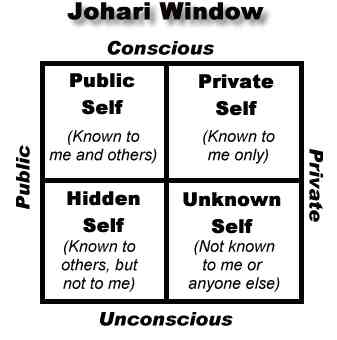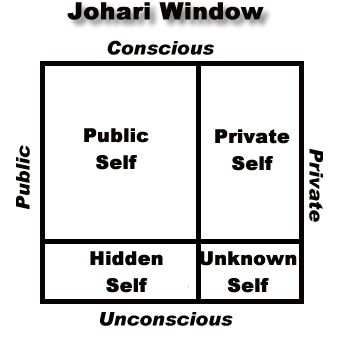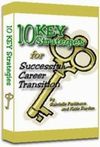 |
Creating
Your Career . . . Designing Your Life |
|
| |
Understanding Ourselves BetterThe most engrossing questions for me have always been "why am I here" and "what makes people tick". The Why question is one that can only be answered on a personal basis, and after decades of exploration, I think I'm a little closer to an answer for myself. Understanding what makes us and others "tick", however, is something that has been widely studied. And luckily for us, there are several useful models out there that can shed a little light on the human condition and our human behaviors. In this article we'll discuss a couple of models that may be useful for you. Johari Window One of the models we can use to begin to understand human behavior is the Johari window. This 4 quadrant matrix suggests each of us is like a house with glass outside walls and solid inside/internal walls.
In the upper left quadrant is the Public Self (public/conscious) that is visible to all. The upper right is the Private Self (private/conscious), those aspects of my personality that only I am aware of. The lower left is the Hidden Self (public/unconscious) which is visible to others, but not to me. And the lower right is the Unknown Self (private/unconscious), invisible to all. We are able to see/understand our own behaviors looking in from the top side of the quadrant, which shows us both our Public and Private Selves - what we personally are consciously aware of. Other people look at us from the left side of the quadrant, seeing both the Public and the Hidden Selves - our observable behaviors. Obviously the Unknown Self, which is both private and unconscious, is simply not viewable, either by us or by others. Using Tools to Make it Simple Those of us who are coaches are in the business of helping others achieve their goals and dreams. Often this means some personal exploration to help clients get rid of blocks, access their own best behaviors, understand what they're doing that does and doesn't already work well, and then developing strategies for becoming more resourceful. So, we looked around for some useful assessments that would assist our clients in better accessing that best within themselves. Our criteria were fairly simple: We were looking for something that was Simple to Understand, Simple to Administer, Simple to Explain, Simple to Apply, as well as something that had been used enough times for the results to be verifiable. We came up with several assessments - including the DiSC and the MAPP - that really helped us to better understand ourselves and others. But 2 of them seemed to stand out in terms of being reasonably priced and meeting our Simple Requirements: the Motivation Profile and the Platinum Rule. Motivation Profile The Motivation Profile is a self-administered workbook that examines various aspects of how we prefer to interact with the world. It's based on Neuro Linguistic Programming (NLP) and gives quick insight into how and why we do the things we do and get the kinds of results we get. Aspects of our self and our interactions identified through this assessment include sensory preferences, environmental preferences, metaprograms, and time preferences, many of which are present as part of the Unknown Self. Bringing these into consciousness can often help us identify and understand areas where we are already resourceful and those where we might want to focus attention or energy to expand our options. Platinum Rule The Platinum Rule (which modifies the Golden Rule so that we do unto others as they would have us do unto them) is a 4 quadrant assessment from Tony Alessandra that can be administered over the internet. This assessment consists of 18 questions which have a range of possible answers. It is very quick to take (usually 3-5 minutes) and the results are instantaneously available.
What you end up with are 4 quadrants where the upper left (Indirect/Open) identifies the Relaters - people who are very good at relating to others, but do not like confrontation and do not like risk. These are classic social workers, mediators, people-oriented people who want to make sure everyone is taken care of and not left out. The upper right quadrant (Direct/Open) are the Socializers - the people who love to interact with others in a social atmosphere. They are often self-disclosing (open) and risk takers, and can be seen as somewhat flamboyant - these are our performers, artists, salespeople, our expressives. They are also people-oriented, but often because they love an audience. The lower right quadrant (Direct/Closed) are the Directors. Directors often have that title at work, too. They are direct, driven, results oriented people who can often be seen as being insensitive because they are more task than people-oriented and do not self-disclose very much. They want results and they often use others to achieve what they want. In the lower left quadrant (Indirect/Closed) we have the Thinkers. These are your classic technicians, accountants, engineers. They are very risk adverse, need lots and lots of data, take a long time to make a decision and are resistant to change. They keep us grounded and accountable. And safe. More Resources = Greater Flexibility = Better & Quicker Results
As we understand and access more of our own unconscious motivators and behaviors, we increase our conscious understanding, which shifts the horizontal access downward. Once we are Conscious of behaviors and motivators, we now have the option of expressing them publicly, too. And so it goes. Another reason we like the Platinum Rule so much is that it provides a way to get more information about the Hidden Self. Not only can you complete the assessment for yourself, there is a unique 360 degree-like opportunity to invite an unlimited number of observers from your business and personal lives to complete the same assessment regarding how they experience you. The individual observer results are confidential, although they are plotted on a graph so the person taking the assessment can better understand how s/he is experienced by other people. And if you're working with a group of people, you can plot a group graph of the individual styles so you better understand where you fit within the group. Understanding the differences in how we see ourselves and how others experience us can help to shrink the Hidden Self quadrant as well as providing valuable feedback regarding our effectiveness. And bottom line, we all want to achieve our desired results more quickly and effectively. By giving ourselves the opportunity to understand our own motivators and behaviors, and using the valuable feedback that assessments and observations can provide, we can shorten the time between desire and achievement, and increase the quality of the results we get.
For More Information about these Assessments If you are a coach or trainer who is interested in learning more about how to use these assessments with your clients, send an email to assessment@careerlife.net.
|
Click
Here to Discover |
 To
understand a Johari window, draw a box, then divide it into 2 columns and 2 rows.
Basically, the horizontal axis (wall) helps us identify behaviors that are public/external
(left side) or private/internal (right side). The vertical axis (wall) contains
our conscious behaviors (top) and unconscious behaviors (bottom)
To
understand a Johari window, draw a box, then divide it into 2 columns and 2 rows.
Basically, the horizontal axis (wall) helps us identify behaviors that are public/external
(left side) or private/internal (right side). The vertical axis (wall) contains
our conscious behaviors (top) and unconscious behaviors (bottom) The
Platinum Rule explores behavior from 2 dimensions - Openness and Directness. How
relatively open or guarded someone is, and how relatively direct or indirect someone
is. So to understand this Assessment, divide your quadrant so that the vertical
axis measures how Open (top) or Closed (bottom) the person is. And the horizontal
axis measures how Indirect (left) or Direct (right) the person is.
The
Platinum Rule explores behavior from 2 dimensions - Openness and Directness. How
relatively open or guarded someone is, and how relatively direct or indirect someone
is. So to understand this Assessment, divide your quadrant so that the vertical
axis measures how Open (top) or Closed (bottom) the person is. And the horizontal
axis measures how Indirect (left) or Direct (right) the person is.  As
we understand ourselves more and more, we are able to tap into the incredible
resources personally available. If we return to our Johari Window model for a
moment we can see that this greater understanding may allow greater confidence
toPublicly express more of what may have been kept Private, thus shifting the
vertical axis to the right.
As
we understand ourselves more and more, we are able to tap into the incredible
resources personally available. If we return to our Johari Window model for a
moment we can see that this greater understanding may allow greater confidence
toPublicly express more of what may have been kept Private, thus shifting the
vertical axis to the right. 